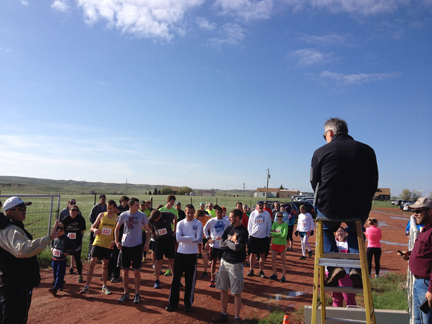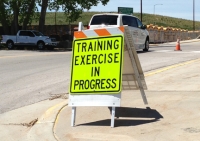

Last weekend there was a 5/10K run/walk at the
Durham Ranch to raise funds for our
Hospice department and to help us serve more patients. The Buffalo Stampede was
a home run—or should I say a buffalo run. The Stampede raised more
than $19K for Hospice, and we couldn’t be more thrilled with the results.
A big thank you goes out to John Flochini and all the folks at the Durham
Ranch for making this a big success. It is yet another reminder of the
great folks who live in Campbell County and who are committed to help
us be a better healthcare organization.
 Also this week, we had an
organized disaster drill. There were more than 100 participants in yesterday’s exercise.
This includes volunteers who played the victims, law enforcement, fire
department, EMS, department managers, evaluators, command center staff
and others from the city, county and school district.
Also this week, we had an
organized disaster drill. There were more than 100 participants in yesterday’s exercise.
This includes volunteers who played the victims, law enforcement, fire
department, EMS, department managers, evaluators, command center staff
and others from the city, county and school district.
The scenario was a “Code Silver,” which is when hospital staff
witness a hostage situation, or an individual brandishing a weapon or
actively shooting within the facility. CCMH has several different “codes”
as part of our Emergency Preparedness plan, such as Code Red (Fire), Code
Blue (Cardiac Arrest) and Code Yellow (Disaster). Code Silver was added
to the list recently, and the exercise was a functional drill to test
not only our response, but our coordination with other entities, such
as local law enforcement and fire.
Another goal was to simulate how we would respond to the situation and with
social media users—a task few disaster preparedness drill teams have stepped
up to in Wyoming. A private Facebook group was created and actors were
asked to post on the site. The Public Information Officer (PIO) used
Facebook to communicate information as it was developing. We normally do at least
two emergency preparedness drills a year, though some are “tabletop”
exercises, and not a full-blown simulation like this one. The exercise
was called about 3:40 pm, and a debriefing with all the participants was
held that day.
Drills like this help us to prepare for disasters that may test the capacity
of our organization to respond in these unfortunate circumstances. The
goal is to give the participants a higher level of preparedness, a more
effective response and a better chance of saving lives in an actual incident.
Our employees, medical staff, volunteers, and local law and fire responded
with professionalism and great expertise. Thanks to all who helped make
this a success.
Andy